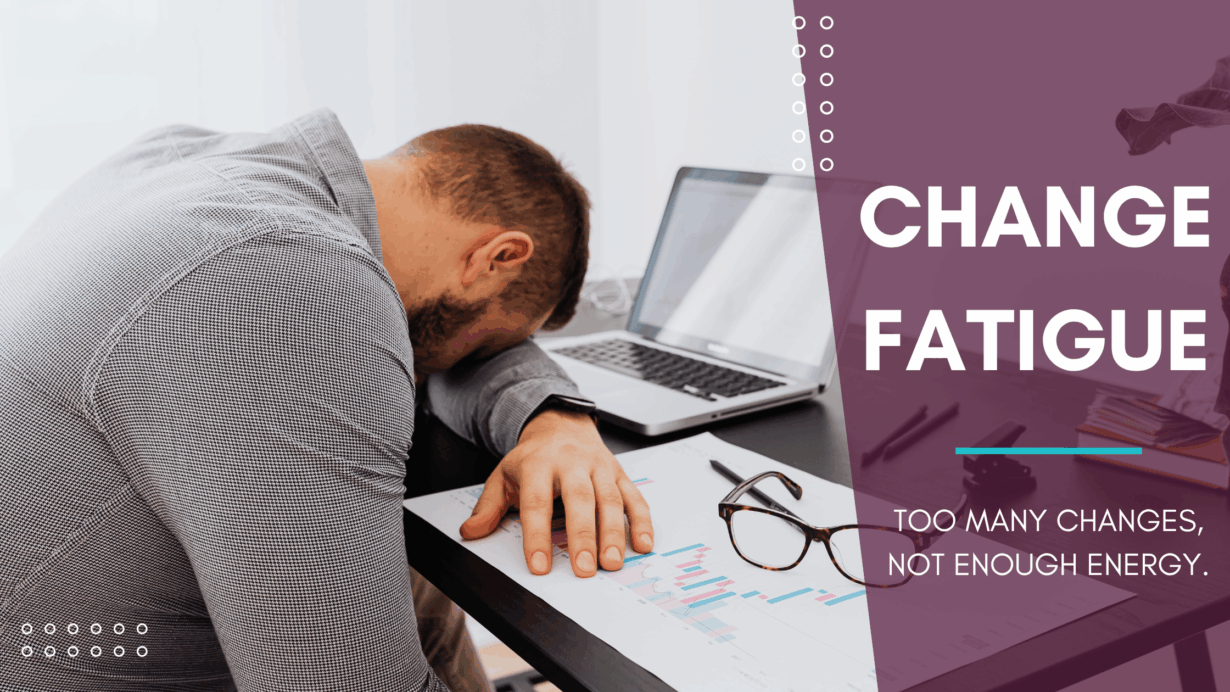Teams juggling constant change initiatives, learning new processes, and frequent shifts in priorities, all at once. Sound familiar?
Burnout at work isn’t just about working too many long hours. It is an emotional, cognitive and physical load which ultimately steals from productivity, positivity, and performance.
The Cost of Change
The risk of burnout in our modern times is prevalent, with 35% of UK employees ‘always’ or ‘often’ facing high or extreme stress and pressure at work in the last year. With burnout and stress comes absenteeism, which cost UK businesses £103 billion in 2023 alone – a £30 billion increase since 2018. It is clear that organisations who could spot and solve increasing cases of burnout can save their organisation a significant amount of income.
Supporting the workforce to thrive in times of change, instead of succumbing to stress and burnout, requires awareness and action on all levels.
What Does Burnout Look Like?

The World Health Organisation defines burnout as “a syndrome conceptualised as resulting from chronic workplace stress that has not been successfully managed.”
One major facet of burnout is change fatigue; 100% of HR leaders notice burnout from change in employees. Change initiatives need to employ a human-centered approach to tackle the figures, but also, individuals, employers, managers and policy-makers need to be aware how they can fight back against burnout, support their teams, and dissipate the cultural norm of stress in the workplace.
Why Change Amplifies Burnout
The repeated organisational shifts required of us in the modern world, with almost-daily tech advancements, increasing mental health awareness, health & safety / regulatory changes, and remote / hybrid working, give us no choice but to employ multiple dynamic changes in the workplace. The feelings of powerlessness, confusion and pressure that can accompany organisational change can erode motivation and resilience. The constant cognitive load of learning new policies, processes and ways of working places strain on workers at any level. Unsurprisingly, these are a large contributor to stress, and eventually, burnout.
It is time to challenge burnout as a cultural norm, and transform overload into adaptability.
What Leadership Can Do

Corporate leaders have an opportunity to re-write the way we view and respond to employee stress, starting with recognising early warning signs of burnout. In times of change, leaders should be on high-alert.
To support your teams in change, provide clear communication; the when, why and who. Predictable routines, instead of uncertainty, helps employees feel in control. Setting realistic expectations of the outcomes of the change keeps everyone on the same page, and gives purpose to initiatives. If a team doesn’t understand why upheaval is even necessary, why should they commit to it?
Once change is underway, celebrating small wins, taking breaks, and having open discussions and reflections are micro-recoveries for employee stamina. In the same way, encouraging psychological safety across the board enables employees to voice their concerns and feel comfortable about it. Workshops, facilitated reflections, and coaching / mentoring can help organisations embed their new practices across the organisation, creating a more resilient and adaptable workforce.
What Individuals Can Do
To empower employees personally, a culture of self-awareness is critical.
Only when employees are aware of themselves, their energy, stress levels, feelings and uncertainties, can they clearly communicate with those they trust and invite action and support. Putting personal boundaries in place, as well as having clear expectations set by leaders reflecting a realistic workload, ensures that out-of-touch policies and mindsets don’t damage motivation. Asking for help is always better than worrying privately. Focussing on what you can control, and letting go of the rest, is important for employees to keep a healthy perspective of any upcoming change initiatives. Small wins are still wins, are should be celebrated to appreciate your teams and their commitment to the current changes.
Encourage a culture where employees can proactively use these strategies, supported by resources, training and guidance, and the workplace will be a place of psychological safety where stress is caught before it festers into burnout.
Remember; change fatigue and burnout is a signal, not a weakness.

If you are noticing it in your teams in response to change, you can protect your people and performance with simple interventions, using the likes of Kotter’s 8-step roadmap to change. This framework focuses on the importance of clarity in the reasons for change, ensuring you have a strong coalition across the organisation ready to step-up and embody the change to mirror to employees, removing the barriers of mindset and apprehension, generating small wins, and embedding new change into organisational culture.
Organisations who invest in recognising stress and burnout in their teams early-on can protect ROI placed into change initiatives and maintain performance and drive.
When was the last time you checked in with yourself or your team?
If you’d like practical ways to burnout-proof your organisation and support your people through all change, big or small, DCo offers bespoke programmes, workshops, guidance and facilitated discussions to help teams thrive and feel safe in times of transition.


